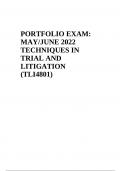PORTFOLIO EXAM:
MAY/JUNE 2022
TECHNIQUES IN
TRIAL AND
LITIGATION
(TLI4801)
, PORTFOLIO EXAM: MAY/JUNE 2022
TECHNIQUES IN TRIAL AND LITIGATION
(TLI4801)
QUESTION 1: CIVIL PRACTICE
1.(a) Blackblue (Pty) Ltd can institute simple summons, in accordance with the High
Court Rule 2(b). This will be liquidated claim made in a simple summons, in terms of
the requirements of rule 17(1) must notify the defendant about 10 days limit to deliver
notice of intention to defend.1 Blackblue (Pty) Ltd will use Form 9 of the First Schedule
to the rules. The simple summons will contain a complete cause of action. A liquidated
claim stating that there is money owed like purchased price of goods sold and is a
liquidated demand or debt.2 The must be a calculation of interest and set out to
consider the liquidated demand, which sets out the abbreviated details of the claim.
Since a quantum is already determined, simple summons is used without any leading
evidence.3
(b) Because the instituted claim is based on liquid documents, Blackblue (Pty) Ltd
can apply for summary judgment order. 4 Other reasons are that there is a liquidated
amount of money; there was a contract of sale, where delivery of there was moveable
property; ejectment and there is a purchase price of goods sold and delivered. 5 What
The defendant Mr Dobbs breached the contract by failing to pay the full price. The
purpose of summary judgment used to obtain an immediate implementation of a claim
against a defendant and protect the plaintiff against defendant who has no bona fide
defence in terms of Rule 14(1).6
(c) Blackblue (Pty) Ltd must issue a declaration pleading. This declaration will be
important in the absence of the summary judgment and actions are simple summons.
It is comparable of the particulars of claim affixed to a combined summons. 7 This file
sets out the plaintiff’s cause of action and prayer for relief. The material fact must be
fully detailed, set out fully and precisely conveyed, in terms of Rule 20. This is insofar
will enable the defendant to argue, during an exchanged of document between parties.
This principle is known as audi et alteram partem. The parties will advance to set the
1
Marnewick CG, Litigation Skills for South African Lawyers, 4th Ed, (LexisNexis), 99.
2
Marnewick CG, Litigation Skills for South African Lawyers, 99.
3
Peté S, Hulme D, Du Plessis M, Palmer R, Sibanda O, Palmer T, Civil Procedure: A Practical Guide Procedural
law, 3rd Ed, (Oxford University Press 2017), 128.
4
Marnewick CG, Litigation Skills for South African Lawyers, 4th Ed, (LexisNexis), 430.
5
Peté S, et al, Civil Procedure: A Practical Guide Procedural law, 269.
6
Peté S, et al, Civil Procedure: A Practical Guide Procedural law, 721.
7
Marnewick CG, Litigation Skills for South African Lawyers, 108.
1




